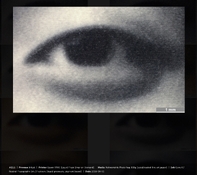OK. 19 days lead time turned out to be a very pessimistic estimate.
It was shipped already after 3 days.
I am quite pleased with the result.
I disabled all the "enhancement options" but I still see a little more sharpening in the print than I see in the file. but not too distracting.
The texture, feel and depth of the baryta paper is exactly what I hoped for.
I will use them again if I have a BW file to print.
So, thanks to those pointing me in that direction!
For those interested in the economy of this print:
I wanted 30cm wide so the file dictated a 30 x 37.9 cm print.
Baryta paper, de-activation of "UltraHD" or "SuperResolution"
Price €48,26 (minus a first order 10% discount = €43,43)
Shipping (fedex) from Germany: €9.40
Maybe not cheap, but fair for what I got.
Below it the Stephen Gill image I printed.
I am sure my choice of will baffle many here. Subject out of focus. Strange bird posture. But I have a special attraction to grey hooded crows as well as un-academic conceptual photography.
I feel I "get" what Stephen Gill is doing.
If you want to see the other choices, go here:
https://www.nobodybooks.com/product/the-pillar-print-your-own-image-options-



